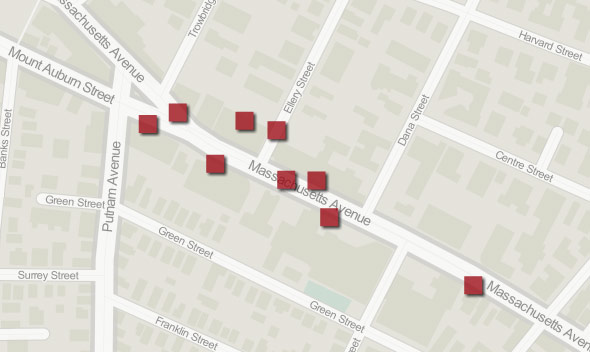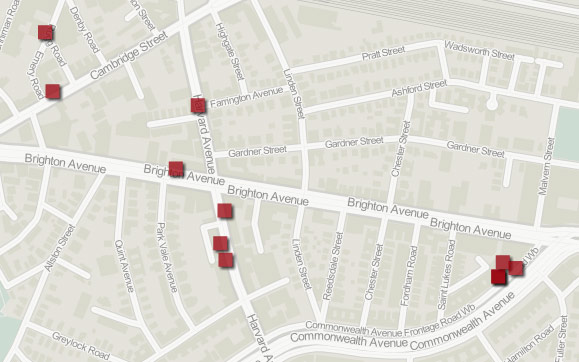One of my favorite Simpsons bits proceeds thus:
Hank Scorpio: Hammocks? My goodness, what an idea. Why didn’t I think of that? Hammocks! Homer, there’s four places. There’s the Hammock Hut; that’s on Third. There’s Hammocks-R-Us; that’s on Third too. You got Put-Your-Butt-There; that’s on Third. Swing Low, Sweet Chariot… Matter of fact, they’re all in the same complex; it’s the Hammock Complex on Third.
Homer: Oh, the Hammock District!
I use “____ District” as often as possible when the wares in question have comedic potential. Furniture is too ordinary to be funny in that context, but it does manage to bring the quotation to mind. Here’s why.

Shortly up the street from me in Cambridge is an unmistakable cluster of furniture retailers on Mass Ave, marked on the map above. It wouldn’t give me pause except that in my wanderings around town I seem to encounter odd pockets of ostensibly independent furniture stores all over the place. Where there is one furniture store, there always seems to be at least another one or two. It’s probably not a uniquely Boston-area phenomenon, but still, what gives?
One easy answer points to colleges, whose students are crucial to the life cycle of furniture: from store to apartment to curb to dirtier apartment, ad infinitum. The area above, for example, is close to Harvard. Allston similarly has a nice furniture district.

But that doesn’t explain a neighboring pair of stores in western Cambridge, or a group in the South End, or the lack of concentrated stores around Northeastern. Or, beyond the clusters in student areas, am I only imagining these Furniture Districts? Perhaps it’s simply the same thing as with, say, CVS and Walgreens, which deliberately open locations across the street from one another, for some reason favoring close competition.
I have mapped 200 hundred Google results for “furniture” using GeoCommons, where simple mash-ups are not made of horribly ugly pushpins*. Take a look (or search Google yourself), dear readers—is there anything to this, and if so what do you think is behind it? A caveat, by the way, is that something’s appearance in these search results does not necessarily mean it’s a furniture retailer; it is, after all, a simple keyword search.
*This, I will boast, is partly because my own company, Axis Maps, designed much of the mapping apparatus a few years ago.
There is one other dedicated furniture store on Harvard Ave, betwixt Comm & Brighton. It’s also probably safe to call Cheap Chic yet another furniture store. Cheap Chic is a thrift store and about half of their inventory is furniture.
The one that is marked on your map has one of my favorite business tag lines of all time, “College Furniture & Rug: We’re cheaper than you.”
When I moved to the Boston area in the late 90’s, I started calling the part of Cambridge along Mass Av near Trowbridge “The Futon District.” In fact, I did purchase my futon at a store there that I think is now out of business. The shops seem to have diversified into more varieties of furniture over the past decade with less emphasis on futons.
Futon District. That’s perfect!
It’s a well known phenomenon – economists refer to these as agglomeration economies. A quick google search on that will turn up decades of research on the topic…
Thanks for the tip. Good to know. I wonder what other interesting examples can be found around Boston.
If you stick with Allston, you could pretty easily generate a “Hairstylist District” map.
i too live near the cambridge furniture district & have wondered how it came to be. i remember when it was more futon-based and appealing to students, but it’s gone pretty upscale now. design within reach of some folks, maybe, but not me.
We need some turtle data! I like turtles!
The Boston turtles and unicorns map is forthcoming.
An explanation might be the delay IKEA took in setting up shop in the Boston area. This usual purveyor of cheap furniture to students and all alike was conspicuously absent from the greater Boston region until 2006 I think.
I worked right near the Mass Ave cluster in 2008 for a few months. While I was there one of the stores closed- since then I’m 95% sure it has been replaced with a different furniture store.
Pingback: The Furniture District - Axis Maps Blog
LA has a wig district in Hollywood (for real).
And Hayes Valley in San Francisco has blossomed into a French Macaroon district
I’ve lived right around the corner for >20 yrs and I have a slightly different take on the Mass Ave “Furniture District.” In fact, the District is adjacent to the old Jewish settlement in Cambridge. There are numerous synagogues nearby for one bit of evidence. Lots of the original owners (and some until recently) were Jewish. Some of the original stores were used furniture or “makeshift” furniture like the Door Store. These are traditional first-generation retail enterprises. The District, like the rest of the neighborhood has changed many times over, even in the last decade or so, but the original cluster of similar-economy stores may reflect the settlement patterns and economic practices/constraints of earlier waves of immigrants.
Fascinating, thanks for this insight! I never knew this was an old Jewish area.